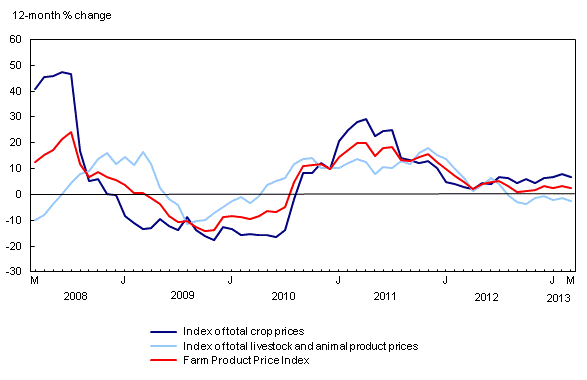Farm Product Price Index, March 2013
Archived Content
Information identified as archived is provided for reference, research or recordkeeping purposes. It is not subject to the Government of Canada Web Standards and has not been altered or updated since it was archived. Please "contact us" to request a format other than those available.
Released: 2013-06-05
The Farm Product Price Index (FPPI) rose 2.4% in March compared with March 2012, as an increase in the crops index more than offset the decrease in the overall livestock and animal products index. The FPPI, driven mainly by rising crop prices, has observed year-over-year increases since August 2010. Double digit increases were recorded up to January 2012; since that time, the rate of growth in the FPPI has slowed.
The crops index rose 6.8% in March compared with March 2012, largely as a result of the higher oilseeds index (+11.8%), which continued a growth trend that started in September 2010. Oilseed prices have been supported by growing demand and concerns over tight supplies. Despite Canada recording its second largest production of canola and its largest production of soybeans in 2012, on-farm stocks of oilseeds were at their lowest level in nine years at the end of March 2013. In the United States, soybeans—the largest oilseed crop in that country—were at their lowest farm stock level since March 2004.
All other crops contributed to the increase, except potatoes (-6.4%). Last fall, the largest combined Canada and US potato production since 2004 boosted North American supplies.
The livestock and animal products index fell 2.4% in March compared with March 2012. This continued the downward trend that started in August 2012.
Declines in the hogs index (-10.5%) and the cattle and calves index (-4.4%) were responsible for the decrease in the livestock and animal products index. This was the eighth consecutive decline for the hogs index. Canadian and United States inventories of hogs in December 2012 remained virtually unchanged after reaching their highest levels last summer since 2008.
Moderating the decrease in the livestock and animal products index were gains in the supply-managed commodities: eggs (+9.0%), poultry (+8.8%) and dairy (+1.8%).
Compared with February, the FPPI declined 0.7% in March 2013, as both the crops index (-0.1%) and the livestock and animal products index (-1.7%) fell.
Note to readers
Starting with this release, the time base used in the calculation of the Farm Product Price Index (FPPI) was changed from 1997=100 to 2007=100. The seasonal marketing pattern was also updated. The seasonal weighting pattern remains constant and is only updated periodically, for instance when the time base is revised. This weighting pattern, which had been based on the monthly marketings from 1994 to 1998, is now based on the monthly marketings from 2006 to 2010.
As a result of rebasing, CANSIM tables 002-0021 and 002-0022 have been replaced by new tables 002-0068 and 002-0069. In addition, a new table, 002-0070, has been created to provide the weights of the major commodity groups in the index, which had previously been available in the publication Farm Product Price Index (Catalogue number21-007-X), now discontinued.
Although the FPPI base year was changed to 2007=100 in the new CANSIM tables, the rates of change measured for periods prior to 2002 remain unchanged for both the 1997=100 and the 2007=100 tables. Beginning in 2002, the rates of change for the indexes reflect the new seasonal weighting pattern as well as changes to commodities moved from the miscellaneous category to a separately calculated commodity category, and vice versa.
The growth rate of the total FPPI is derived from a weighted average of the component indices using a different set of weights in consecutive months; it is not a weighted average of the growth rates of its crop and livestock components. Given this, the growth rate of the composite FPPI can lie outside the growth rate of these components.
Contact information
For more information, or to enquire about the concepts, methods or data quality of this release, contact us (toll-free 1-800-263-1136; infostats@statcan.gc.ca) or Media Relations (613-951-4636; statcan.mediahotline-ligneinfomedias.statcan@canada.ca).
- Date modified:


